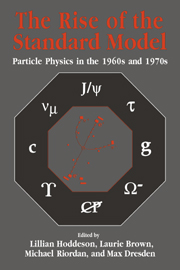Book contents
- Frontmatter
- Contents
- Contributors
- Editors' Acknowledgments
- Photographs of the Symposium
- Abbreviations and Acronyms
- Mathematical Notation
- Part One Introduction
- Part Two Quarks and Leptons
- Part Three Toward Gauge Theories
- Part Four Accelerators, Detectors, and Laboratories
- 15 The Rise of Colliding Beams
- 16 The CERN Intersecting Storage Rings: The Leap into the Hadron Collider Era
- 17 Development of Large Detectors for Colliding-Beam Experiments
- 18 Pure and Hybrid Detectors: Mark I and the Psi
- 19 Building Fermilab: A User's Paradise
- 20 Panel Session: Science Policy and the Social Structure of Big Laboratories
- 21 Some Sociological Consequences of High-Energy Physicists' Development of the Standard Model
- 22 Comments on Accelerators, Detectors, and Laboratories
- Part Five Electroweak Unification
- Part Six The Discovery of Quarks and Gluons
- Part Seven Personal Overviews
- Index
15 - The Rise of Colliding Beams
Published online by Cambridge University Press: 03 February 2010
- Frontmatter
- Contents
- Contributors
- Editors' Acknowledgments
- Photographs of the Symposium
- Abbreviations and Acronyms
- Mathematical Notation
- Part One Introduction
- Part Two Quarks and Leptons
- Part Three Toward Gauge Theories
- Part Four Accelerators, Detectors, and Laboratories
- 15 The Rise of Colliding Beams
- 16 The CERN Intersecting Storage Rings: The Leap into the Hadron Collider Era
- 17 Development of Large Detectors for Colliding-Beam Experiments
- 18 Pure and Hybrid Detectors: Mark I and the Psi
- 19 Building Fermilab: A User's Paradise
- 20 Panel Session: Science Policy and the Social Structure of Big Laboratories
- 21 Some Sociological Consequences of High-Energy Physicists' Development of the Standard Model
- 22 Comments on Accelerators, Detectors, and Laboratories
- Part Five Electroweak Unification
- Part Six The Discovery of Quarks and Gluons
- Part Seven Personal Overviews
- Index
Summary
My own career in science has been intimately tied up in the transition from the old fixed-target technique to colliding-beam work. I have led a kind of double life as both a machine builder and as an experimenter, taking part in building and using the first of the colliding-beam machines, the Princeton–Stanford Electron–Electron Collider, and building the most recent advance in the technology, the Stanford Linear Collider. The beginning was in 1958 and, in the more than three decades since, there has been a succession of both electron and proton colliders that have increased the available center-of-mass energy for hard collisions by more than a factor of 1000.
The history of that advance for both electron and proton colliders (constituent center-of-mass energy is plotted versus time of the first physics experiment) is shown in Fig. 15.1. The important number for the experimenter, the constituent center-of-mass energy, has increased by about a factor of 10 every 12 years for both kinds of systems. On the electron line, one can see a kind of complete cycle in accelerator technology from the birth of the colliding-beam storage ring, to its culmination in LEP II, and the beginning of the next technique for high-energy electron collisions, the linear collider. On the proton line, one has gone from the first bold initiative, the ISR at CERN, which used conventional magnets, to the superconducting magnets that are used in all proton colliders built today.
- Type
- Chapter
- Information
- The Rise of the Standard ModelA History of Particle Physics from 1964 to 1979, pp. 261 - 284Publisher: Cambridge University PressPrint publication year: 1997
- 2
- Cited by



